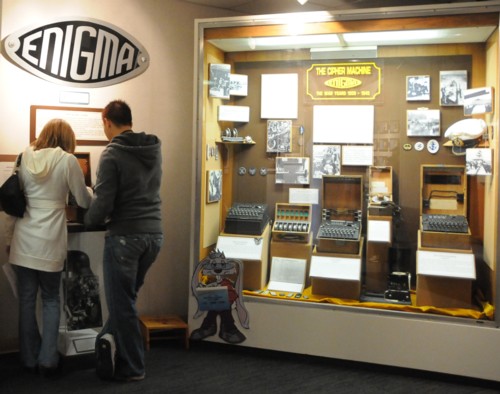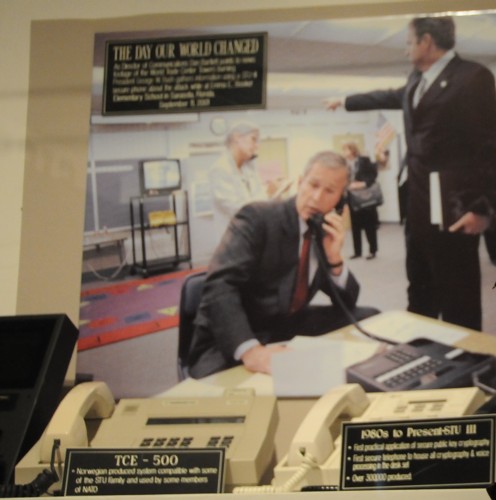
The celebrity of the exhibit is Enigma -- an electromechanical, wired-rotor machine used by Nazis in World War II to render a radio message unintelligible; Allies cracked the code © 2010 Karen Rubin/news-photos-features.com
Can't get enough of the WikiLeaks saga of unmasked state secrets? Still smarting over the revelation that the NSA was eavesdropping on Americans without a warrant? Are you hooked on the spy v. spy intrigues of Cold War? Or does the mysterious Enigma capture your imagination?
Then have I got a place for you.
Tucked away in the woods adjacent to National Security Agency headquarters, itself, hiding almost in plain sight is The National Cryptologic Museum, the first and only public museum in the intelligence community. The museum hosts 50,000 visitors annually, letting them peek into the secret world of code-making and code-breaking, and discover how this art and science impacted how world events unfolded.
The modest building houses a cramped collection of thousands of artifacts that collectively serve to sustain the history of the cryptologic profession. Here visitors can catch a glimpse of some of the most dramatic moments in the history of American cryptology: the Zimmermann cable that brought the United States into World War I; Enigma, the encoding machine that Hitler was convinced could never be broken (but was), the voice-encrypting secure phone that presidents use to talk with other world leaders and that Bush used to receive word of the 9/11 attacks; NSA's first super-computers; the first reconnaissance satellite; artifacts from the U-2 and the Pueblo.
The only way to really appreciate what you are seeing, though, is to take a docent-led tour. Docents like Sharon Repta, whose tour we joined, are retired NSA personnel.
We stop in front of a display that describes the code-breaking intrigue surrounding the Zimmermann Telegram.
It was 1917. World War I was raging in Europe. The British wanted the United States to help defeat Germany. In an episode that resonates today with WikiLeaks publication of diplomats' communications, the British had intercepted a cable from Germany's Foreign Secretary Arthur Zimmermann to Mexico, offering Mexico some of the territory that it had lost to the United States in the Mexican-American War if they would support Germany. President Woodrow Wilson "leaked" the contents of the cable to the Associated Press on March 1. The headlines about the proposed alliance angered and shocked the American public, which went from being isolationist to wanting the US in the fight. Wilson declared war against Germany and its allies on April 6.
The celebrity of the exhibit, though is Enigma -- an electromechanical, wired-rotor machine used by Nazis in World War II to render a radio message unintelligible to anyone but the intended recipient. Hitler believed the code was unbreakable, but here we see how it was eventually cracked by the Allies.
A display of photos honors "The Average Americans Who Rose to the Challenge and Broke the 'Unbreakable' Cipher." The reference is to the team that cracked the Japanese Purple cipher, enabling the Allies to have insight into battle strategies including Midway, affecting the outcome of the war.
William Friedman's group (in particular Frank B. Rowlett) developed a machine similar to, but more flexible than the Enigma device. Called SIGABA, the machine was so successful that during the war, the German cryptanalysts gave up on even recording their intercepts of the messages. They found it impregnable.
Soviet codes from a listening post that gathered intelligence from the 1930s to 1950s that were only broken in the 1980s, Repta said, proved that Alger Hiss and Julius Rosenberg were spies, but not Ethel Rosenberg. (Both Rosenbergs were executed in 1953 for betraying atomic secrets to the Soviet Union during World War II.)
Repta, who had worked at NSA beginning in the 1960s, stands in front of a reconnaissance satellite -- surprising because it is so small -- and says that just whispering about its existence then would have been treasonous.
She knows because just across the room is a wall of infamy of moles and double agents.
There are also displays that remind of intelligence failures -- like the capture of Gary Powers and the U-2 spy plane, and the ship, the Pueblo, loaded with secret technology.
There is nothing of the intelligence intercepts from the September 11, 2001 attack -- not the most famous message of all that warned of the impending attack but was not translated in time (perhaps in the future, after wounds heal). But there is on display a fragment from the Pentagon building where the third plane hit. A plaque reads, "We will come together to strengthen our national intelligence capability to know the plans of the terrorists before they act." (9/20/01, George W. Bush).

Secure phones used by presidents, including George W. Bush on Sept. 11, 2001, on view at the National Cryptologic Museum © 2010 Karen Rubin/news-photos-features.com
One of the displays is devoted to artifacts donated by David Kahn, author of The Codebreakers and former journalist and editor at Long Island's Newsday. In that display is Johannes Balthasar Friderici's book, Cryptographia, from 1684.
But the historical piece de resistance from his collection will go on display in the future: a signed 1806 letter from the Emperor Napoleon to his son Prince Eugene Napoleon. In the letter Napoleon instructs his son to "keep sending me the letters from the Archbishop of Silesia sent from Rome to Dresden. The key has been found here so that they can be read just like ordinary writing. But it is necessary to let them continue on their way while copying them exactly." -- a reference to Napoleon spying on the archbishop.
The Museum's reference library maintains a collection of unclassified and declassified books and documents relating to every aspect of cryptology. The books and records complement the museum exhibits and artifacts, but also offer unique and in-depth sources of information for researchers.
The Wall of Honor reflects that the museum is dedicated to the people who devoted their lives to cryptology and national defense -- for the most part, working secretly, in the shadows and therefore unrecognized and unappreciated -- the machines, devices and techniques they developed. The visitor comes away with a new understanding of some key events in American and world history and are humbled by the thought of how differently things could have turned out. For the cryptologic professional, it is an opportunity to absorb the heritage of the profession, and come out of the shadows to receive justified recognition.
Visiting the museum, you realize that codes and code-breaking are ancient - even the Phoenicians had codes. And the methods and techniques are as sophisticated as space satellites and as basic as the Navajo language. But in each instance, there is human ingenuity - a cat-and-mouse game. And the ramifications of the work, done mainly in tiny cubicles, can have extraordinary impact on the course of history.
Adjacent to the museum, the National Vigilance Park showcases two reconnaissance aircraft used for secret missions. The RU-8D serves to represent the Army Airborne Signal Intelligence contribution in Vietnam and the C-130 memorializes an Air Force aircraft that was shot down over Soviet Armenia during the Cold War.
The National Cryptologic Museum is located adjacent to the NSA/CSS at Ft. Meade, Maryland (directions), and is open to the public. Admission is free. It is open Monday-Friday 9 - 4; Saturdays (first and third of the month) 10 - 2 pm; 301-688-5849 begin_of_the_skype_highlighting 301-688-5849 end_of_the_skype_highlighting
Other Places to Unmask Secrets
Your exploration into the world of secrecy should also include the International Spy Museum, (Fee, 800 F St. NW, Washington, DC 20004, 202-eye-spy-u, www.spymuseum.org).
A polar opposite to the National Cryptologic Museum, which is devoted to the art of secrecy, the Newseum is dedicated to those whose job it has been to expose secrets and serve as a watchdog on government (Fee. 555 Pennsylvania Ave., N.W., Washington, DC 20001, 888/NEWSEUM, newseum.org).
The National Museum of Crime & Punishment includes a crime lab and the filming studios for America's Most Wanted (Fee. 75 7th St. NW, Washington , D.C. 20004, 202-393-1099, www.crimemuseum.org.
See the full story and slideshow here.
______________
© 2010 Travel Features Syndicate, a division of Workstyles, Inc. All rights reserved. Visit www.examiner.com/eclectic-travel-in-national/karen-rubin Send comments or questions to FamTravLtr@aol.com. Blogging at goingplacesnearandfar.wordpress.com.